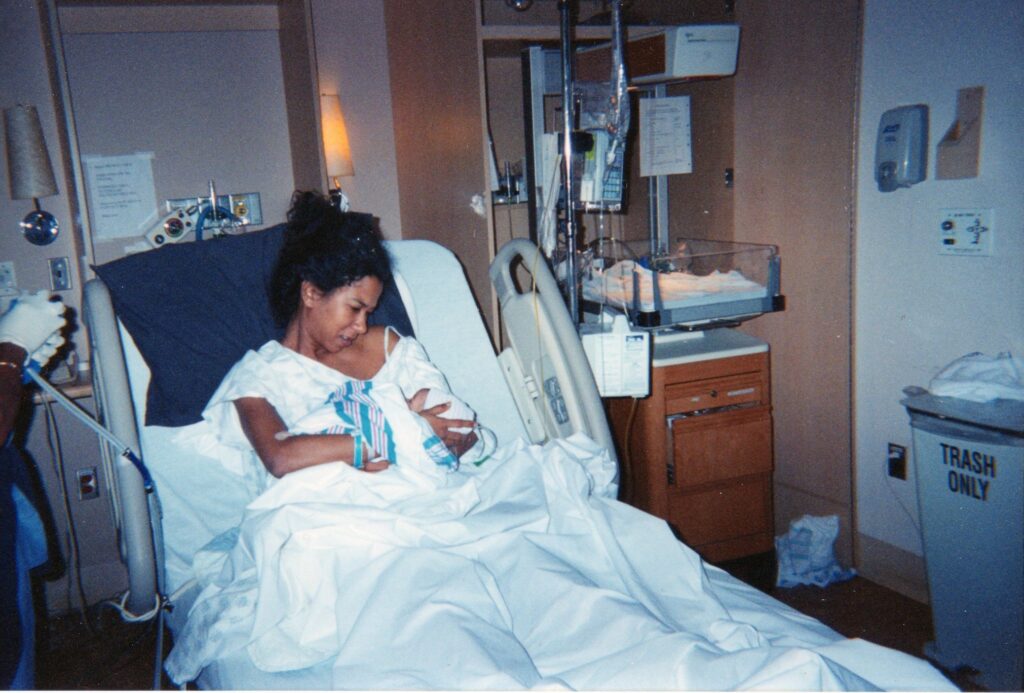How Racism Gets Baked into Medical Decisions
By Patricia Kullberg
December 21, 2020

Patricia Kullberg spoke with Naomi Nkinsi, a third-year medical student at the University of Washington and a candidate for a Master of Public Health, about race-based medicine. This interview originally aired on the Old Mole Variety Hour for KBOO Community Radio, in Portland, Oregon, on August 10, 2020. It has been edited for length and clarity.
The audio can be found embedded in full below.
Patricia Kullberg: I’m speaking with a special guest today, medical student Naomi Nkinsi, about how racism gets embedded into medical science. In the past year, she led a successful effort at [the] University of Washington to get the UW Medical Center to abandon a so-called “race correction” for a commonly used clinical test.1 We like to think that medical science is objective and fact-based, because it’s science after all. Supposedly it’s based on rational thought and experimentation, but it turns out this isn’t always the case. I’d like to start, Naomi, with your telling of this particular test of kidney function and what is so problematic about it.
Naomi Nkinsi: This particular test is used to measure something we call eGFR or estimated Glomerular Filtration Rate.2 It measures the rate at which your kidneys filter toxic metabolic products. In the urine, you get a by-product of muscle breakdown called creatinine. What this test does is measure the filtration rate of creatinine to give us an estimate of how functional someone’s kidneys are. In order to measure this, we use an equation called MDRD [Modification of Diet in Renal Disease]. In this equation, along with gender and age, race is taken into consideration, more specifically, whether the person is Black or not Black.3 If the patient is Black, the result is multiplied by a factor of 1.21.4 What this means clinically is that, if you are a Black patient, you could be filtering creatinine at the same level as a non-Black person but, because the eGFR is calculated with a multiplying factor, your kidney function will look artificially better. This means that, if you are a Black individual, it takes a higher level of kidney disease before you are diagnosed as having kidney dysfunction.5 This plays a large role in clinical practice because eGFR is measured in order to determine who can get a kidney transplant.6 We prioritize kidney transplantation for people who have lower kidney function. If you are Black person, then it takes longer for you to get to the point of eGFR functioning that would qualify you for a kidney transplant. The result is that Black patients wait on kidney transplant lists for longer periods of time, have more end-stage kidney disease before they get the treatment they need, and suffer poorer health outcomes when compared to non-Black individuals.7
PK: Was there any science behind this “race correction”?
NN: There was a study in 1999 called the MDRD study.8 This study of 1,628 participants aimed to find a better way to measure kidney functioning that was less invasive and more accurate than what we had at the time. The study found that when they were measuring people’s creatinine, which is a measure of muscle breakdown, Black individuals had higher levels of creatinine in their urine. From this, they jumped to the conclusion that, if you were a Black person, it meant you had greater muscle mass and your creatinine level wasn’t actually predictive of your kidney function; it was because you were Black and you, therefore, had more muscle. It’s important to note that, in this study, the assumption that Black people had more muscle mass was not founded on any type of accurate science. They cited three studies that attempted to identify differences in body composition between Black and white individuals. These studies were problematic in that there were issues with the participants’ consent to be studied, and also that the researchers were the ones who determined who was Black and who was white. So by looking at a person, they said, “This person is Black and this person looks white.” The definitions of race actually differed between the studies. They were flawed studies and the fact that they are used as a justification for the race correction is also problematic.
PK: Let’s turn to how you organized against this deeply flawed race correction.
NN: I became involved in my first year of medical school. We had a lecture in which we were taught the MDRD equation, and we were taught that race plays a role in kidney function, in particular Black race, and no further explanation was given to our class. In the Seattle cohort of UW students, I’m one of five Black people; so you can imagine, I was sitting in class surrounded by people that, in general, don’t look like me, being taught by a white professor and listening to him saying that my body was inherently inferior or physiologically different because of the amount of melanin in my skin. In that lecture, I asked: “What is the physiological pathway that links melanin to kidney function? How do you identify a patient as Black? What happens if the patient is mixed race or doesn’t look Black to the physician, but has Black ancestry?” And the only response given was that Black people have more muscle mass. I’m someone who grew up running track and field and cross country in middle and high school and that was always an argument that you heard as a stereotype, that, “Oh, you’re running fast, because Black people have more muscle.” The fact that this was being touted as science and being taught to medical students, who would then perpetuate it with their own patients, was so mind-boggling to me, because in every other aspect of our education we’ve been asked to focus on precision and evidence. And something like this, with so little evidence, was still being used today and having an impact on patients.
From there, I met with one of my professors. I talked to him about why I felt this was problematic and the research that showed that having race included in eGFR led to poorer outcomes for Black patients. I then worked in partnership with the Antiracism Action Committee at our school, which takes students’ concerns and brings in faculty members to facilitate conversations. Other students who weren’t Black students, but had heard my complaints, came forward and they took on the burden of meeting with faculty to explain the issue. It started as a student movement and then we had buy-in from faculty who became allies, and they took it upon themselves to round up their own colleagues and discuss with them about why this test was problematic. Laboratory Medicine, Nephrology, Internal Medicine and Family Medicine then got together and did an investigation of the UW patient population to determine whether or not a change in the test would be feasible.9 Based on a memo reporting their findings, they found that there was no physiological difference in kidney function between Black patients and others.
PK: Could you tell us a little bit about an interesting study that came out in the New England Journal of Medicine just this past June about race-based algorithms?
NN: This study pointed out all the different ways that race is built into algorithms that are used to make clinical decisions, for example, for pulmonary function tests, for the kidney tests that we talked about, or to determine if someone in labor needs a c-section or a vaginal delivery.10 This was a study that really laid it out plain and simple that race is built into these algorithms and, in all cases, [are] inappropriate because race is not biological.11
PK: As I recall from reading the article, nearly all the consequences were unfavorable to African Americans in a clinical setting.
NN: Yes. Again, these algorithms reinforce the idea that Black bodies are physiologically different [from] others and that they are inherently inferior; so, putting the race corrections into the algorithms sets in stone that a patient who comes in and is Black will be getting different care from non-Black patients.
PK: There are observed differences between the races in clinical medicine. For example, Black people have more hypertension, and they appear to have greater salt sensitivity than people who [are] not Black, and this has led to the practice of so called “race-based medicine.” I think the original impulse was that a race-based practice would potentially bring benefits to people of color. Tell us a little bit about this and the problems with it.
NN: The issue with race-based medicine at its core is that it implies that race is biological when it’s not. Race is a social construct. And what we are trying to move toward is, rather than seeing race as a risk factor for certain diseases like hypertension, we see that racism and the impact of racism is that risk factor. People thought race-based medicine would lead to better outcomes for people of color, particularly Black people, but that hasn’t been the case and part of it is because race doesn’t really exist. It’s fluid and the definition of race has changed over time. What we should be moving toward is looking at genetics. When we say race we are using it as a proxy for genetic ancestry. Moving away from race-based medicine is a way to be more precise in the language we use and the care we give.
PK: When I was in practice, it seemed to me that clinicians and researchers always wanted to explain things in terms of bad luck, bad behavior, or bad genes. And that bad environment and bad social conditions were much less likely to be part of the explanatory model. While I think you might agree with that assessment, you’re also saying that there is some value in understanding ancestry, which is not the same as race.
NN: Yes. One example I can give is sickle cell disease.12 It’s a disease that misshapes your red blood cells, which carry oxygen throughout your body, and can lead to severe pain and a host of other issues. Sickle cell disease is traditionally taught as a disease that impacts Black people.13 The reasoning they give is [that] Black people have ancestry in Africa and, in parts of Africa, malaria is endemic.14 Black race is once again being used as a proxy for something else. Sickle cell disease is common in all populations that have ancestry in areas where malaria is endemic, including parts of South America, parts of the Mediterranean, and parts of Europe, not just Africa.15 This is another example where race and ancestry and genetics are all blended together when they are separate things.
PK: It sounds to me like you have many issues you could tackle as an activist. In doing that work, what has been your experience? How has it gone for you?
NN: It’s interesting because I tend to get support from other students, particularly students of color. But when it comes to support from faculty or the administration of the school, that only tends to come after media outlets pick things up and congratulate the school. But during the process of speaking out, there is a lot of pushback. One specific example I can give is that our school is regional; so, we do rotations in all parts of the Pacific Northwest and a lot of those areas are very rural, predominantly white areas. So, during a question and answer panel, I spoke up to ask about how students of color, especially Black students or students that, for example, wear hijabs [that] will make them more visible than others, how do we protect those students when going into more rural areas that might not be as open to them. The response I got back from one of the deans was an email saying that my question asking about racism in these communities was offensive and that the video recording would be edited to remove my question before it was disseminated out to students.
NN: Literally erased. So, this is the kind of pushback we face when we bring up these issues. That’s only one example. I’ve had numerous others. It’s very odd because I appreciate that changes are made and I appreciate being recognized for it, but it’s also like a slap in the face because I know that in the process of being an activist and calling for these changes I haven’t been treated well. It’s only now that people are getting positive feedback from the community that I’m being touted as someone to celebrate. But that hasn’t always been the case.
PK: Is there anything else you would like to say about your experience in confronting these well-established and racist practices and attitudes within clinical science and medical education?
NN: I’d like to just point out the labor that students have put into making these changes to make medicine and medical education more anti-racist, and it’s really disappointing to see that students, especially Black students and Indigenous students and other students of color, are having this labor put on them when it’s not compensated and they are often facing retaliation, when it should be the job of the institutions to be pushing for these changes. I want to shout out the students who have been doing this work for years and to also give credit to others, like Dr. Nwamaka Eneanya and Dr. Vanessa Grubbs, who have spent decades specifically on the eGFR work that is only now starting to get recognition.
PK: Naomi, it sounds like there are a lot of people who have contributed to the work of getting racism out of the practice of medicine. This is Patricia Kullberg and I’ve been speaking today with Naomi Nkinsi, activist, medical student and candidate for a Master’s degree in Public Health at the University of Washington. You can find Naomi and message her on Twitter @NNkinsi.
About the Author
Patricia Kullberg, MD, MPH, is a retired primary care physician who served for two decades as the Medical Director of Multnomah County Health Department in Portland. She is currently a science writer for Oregon Physicians for Social Responsibility and contributes frequently to KBOO community radio on health related issues.
Editors
Lisette E. Torres-Gerald (Lead Editor)
Emma Harnisch (Co-Editor)
Marco Baity Jesi (Technical Editor)
Nathan Foster (Copy Editor)
Søren Hough & Matt Moss (SftP Online Editors)
References
- Elizabeth Lawrence, “In medical schools, students seek robust and mandatory anti-racist training,” The Washington Post, November 8, 2020, https://www.washingtonpost.com/health/racism-medical-school-health-disparity/2020/11/06/6608aa7c-1d1f-11eb-90dd-abd0f7086a91_story.html.
- “What is a Glomerular Filtration Rate (GFR)?” WebMD, last reviewed January 27, 2020, https://www.webmd.com/a-to-z-guides/glomerular-filtration-rate.
- Andrew S. Levey, “MDRD GFR Equation,” MDCalc, accessed December 11, 2020, https://www.mdcalc.com/mdrd-gfr-equation.
- “The Calculator: MDRD Calculator,” The Calculator, accessed December 11, 2020, https://www.thecalculator.co/health/MDRD-Calculator-1065.html.
- Salman Ahmed et al., “Examining the Potential Impact of Race Multiplier Utilization in Estimated Glomerular Filtration Rate Calculation on African-American Care Outcomes,” Journal of General Internal Medicine (October 15, 2020), https://doi.org/10.1007/s11606-020-06280-5.
- François Gaillard, Christophe Legendre, and Christine A. White, “GFR Assessment of Living Kidney Donors Candidates,” Transplantation 103, no. 6 (June 2019): 1086–1093, https://journals.lww.com/transplantjournal/Fulltext/2019/06000/GFR_Assessment_of_Living_Kidney_Donors_Candidates.12.aspx.
- Tom Simonite, “How an Algorithm Blocked Kidney Transplants to Black Patients,” Wired, October 26, 2020, https://www.wired.com/story/how-algorithm-blocked-kidney-transplants-black-patients.
- Andrew S. Levey et al., “A More Accurate Method to Estimate Glomerular Filtration Rate from Serum Creatinine: A New Prediction Equation,” Annals of Internal Medicine 130, no.6 (March 16, 1999): 461-470, https://www.acpjournals.org/doi/abs/10.7326/0003-4819-130-6-199903160-00002.
- “UW Medicine to Exclude Race from Calculation of eGFR (Measure of Kidney Function),” Department of Medicine: News and Events, May 29, 2020, https://medicine.uw.edu/news/uw-medicine-exclude-race-calculation-egfr-measure-kidney-function.
- Darshali A. Vyas, “Hidden in Plain Sight: Reconsidering the Use of Race Correction in Clinical Algorithm,” New England Journal of Medicine 383, no. 9 (August 27, 2020): 874-882, https://www.nejm.org/doi/full/10.1056/NEJMms2004740.
- Megan Gannon, “Race is a Social Construct, Scientists Argue,” Scientific American, February 5, 2016, https://www.scientificamerican.com/article/race-is-a-social-construct-scientists-argue.
- “Complications and Treatment of Sickle Cell Disease,” Centers for Disease Control and Prevention: Sickle Cell Disease, last reviewed June 3, 2020, https://www.cdc.gov/ncbddd/sicklecell/treatments.html.
- “Data and Statistics on Sickle Cell Disease,” Centers for Disease Control and Prevention: Sickle Cell Disease, last reviewed October 1, 2019, https://www.cdc.gov/ncbddd/sicklecell/data.html.
- Azfar-E-Alam Siddiqi, Lanetta B. Jordan, and Christopher S. Parker, “Sickle Cell Disease — The American Saga,” Ethnicity & disease 23, no. 2 (July 28, 2013): 245-248, https://pubmed.ncbi.nlm.nih.gov/23530308/.
- “Protective Effect of Sickle Cell Trait Against Malaria,” Centers for Disease Control and Prevention – Malaria – Biology, last reviewed July 16, 2020, https://www.cdc.gov/malaria/about/biology/index.html.





